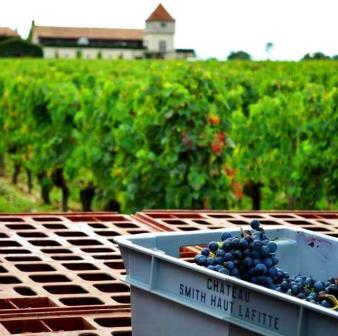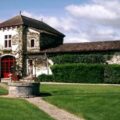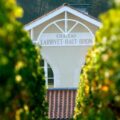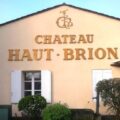Jeff Leve What are your early thoughts on the 2012 Smith Haut Lafitte wines?
Fabien Teitgen “I’m optimistic. The first lots of the Merlot were a real surprise! The wine has good texture, ripe fruit and freshness. 2012 Smith Haut Lafitte is a true Bordeaux wine.”
Jeff Leve With that in mind, does 2012 Smith Haut Lafitte remind you of any previous Bordeaux vintage?
Fabien Teitgen “It’s very difficult to say, because each year is different. Every vintage has its own character. But this year could appear as 2008 vintage for the red wine with a good level of maturity in the grapes with a concentration of tannin, good shoulders and freshness for the aromatics. For the white wine, perhaps 2010 with more elegance.”
Jeff Leve Some vintages the fruit decides the quality and character. In other years, it’s the terroir. Which was a bigger factor with 2012 Smith Haut Lafitte?
Fabien Teitgen “I think that the influence of the soil was stronger than the varietal. The key of the vintage was the water regulation of the soil. If you had good vines with deep roots in an early terroir with a few quantities of water as we had in gunzienne gravel soil, you could have very good result with Cabernet Sauvignon and Merlot. It was more difficult with Cabernet Franc, because they keep some heterogeneity.”
Jeff Leve 2012 Smith Haut Lafitte and 2008 share late harvest dates. Do you like those types of vintages?
Fabien Teitgen “I like late harvest, because the temperatures during the final maturation are cooler and the grapes keep more balance and more freshness for the aromas. But I prefer dry and late harvests!”
Jeff Leve Similar to 2008, did any specific terroir perform best for you with 2012 Smith Haut Lafitte?
Fabien Teitgen “This year we had very good results with our ‘classical’ gunzienne gravels soils and terroir with more clay.”
Jeff Leve Why?
Fabien Teitgen “Because the vines had no problems with drought. But, as the gravels terroirs are very early, I think, we have better maturity and more elegance in the wines from the gravels soils.”
Jeff Leve If you did not have problems with drought, what issues did you experience that were difficult for you with the 2012 Smith Haut Lafitte?
Fabien Teitgen “First, the beginning of the growing of the vines, with the cool temperature in April, the vines began and stopped growing. The vines stayed in a quite strange position during 2 weeks, with heterogeneity. Second, the mildew, just after flowering, was not so easy to control, but we had quite good results. In April, the biggest problem was the cool temperature. In the beginning of April, the vines begun to grow, but after the weather change and became very cold. The growing stopped and the wine stayed without evolution during two weeks with big differences of growing between different branches, or different s buds, or different feet. This phenomenon was less important for Cabernet Sauvignon. Third, the drought for the young vines in last fifteen days of August when some of the young vines lost their leaves.”
Jeff Leve Did you have problems with the flowering?
Fabien Teitgen “This year the flowering was uneven because the bud burst was uneven and because the growing of the vines was strong in May. So to fight against this phenomenon we need to help the maturity. We performed a big green harvest on the on the plants. We removed the bad branches. We also opened early the canopy on the east face to help the maturity of the grapes. We sought a small number of grapes on each foot, as we always pruned short the vines. Lastly, we needed to make a sort of green harvest called queue de véraison. Queue de véraison is where we cut the grapes or the part of grapes which were too late at the end of the véraison. We removed the green part of grapes.”
Jeff Leve What was the best part of the growing season for 2012 Smith Haut Lafitte?
Fabien Teitgen “As the growing of the Cabernet Sauvignon was later than the Merlot, we had less heterogeneity for the Cabernet. So the flowering end the veraison was shorter and we could found a good level of maturity for the Cabernet in our early Graves/Pessac Leognan terroir.
Jeff Leve What was the summer like for you?
Fabien Teitgen “We had a dry summer with good stress for the vines, perhaps it was too strong for the young s vines, but we ended up with a good concentration of polyphenols” We had a very good month with hot temperatures between August 15 and September 13, which also gave us a good difference of temperatures between day and night. That month was very good for the maturity of the grapes.”
Jeff Leve When did you start harvesting 2012 Smith Haut Lafitte?
Fabien Teitgen “The young vines for the white wines had problems with drought during the summer, so they were ready quite early. We began picking Sauvignon Blanc September 13, Sauvignon Gris, September 21 and we finished with Semillion on September 24. For the red wine, we started with Merlot October 4, Cabernet Franc October 10 and Cabernet Franc, October 17.”
Jeff Leve When did you finish picking?
Fabien Teitgen “For our white Bordeaux wine, we finished harvesting the Sauvignon Blanc, September 21, the Sauvignon Gris September 21 and the Semillion September 27. For the red wine, we finished the Merlot October 14. The Cabernet Sauvignon and Cabernet Franc both finished October 17.”
Jeff Leve What were the conditions like for you during the harvesting?
Fabien Teitgen “Between the beginning of harvest and the 6, 7 of October, the conditions were very good. The nights were cool. We picked the grapes in good conditions and with good temperatures. The weather was dry and not too hot.”
Jeff Leve How many pickers did you employ to work the 2012 Smith Haut Lafitte harvest?
Fabien Teitgen “We began with 50 60 people for the white wine. For the red we used 100 people for beginning. But after the bad weekend of October 6 and 7, we were up to 200!”
Jeff Leve After October 6 and 7, did you finish picking much earlier than anticipated?
Fabien Teitgen “Yes, after that weekend we saw an evolution of botrytis, especially on ripe grapes. We decided to accelerate the harvest because the grapes were good and we had a risk with botrytis. In fact the very good weather conditions in September helped the maturity of the grapes and give us the ability to pick good grapes earlier then we though.”
Jeff Leve You were one of the early proponents of optical sorting. Did you use it for the 2012 Smith Haut Lafitte harvest?
Fabien Teitgen “This year, it was difficult to separate the berries from the stems. We had more small parts of stem with the berries and we had some heterogeneity in the berries of Cabernet Franc. We used optical sorting for these things with very good results. The machine was very efficient.”
Jeff Leve What was the big difference between what you had to sort last year with the 2012 Smith Haut Lafitte vintage?
Fabien Teitgen “Last year we had green and pink berries to sort. With the 2012 Smith Haut Lafitte, we had less unripe berries. But we had more small parts of the stem to remove. So the sorting was very important to see that we only had clean, ripe berries in the vats.”
Jeff Leve What are your yields with the 2012 Smith Haut Lafitte?
Fabien Teitgen “We are around 30 hectoliters per hectare.”
Jeff Leve What are your alcohol levels?
Fabien Teitgen “We are between 13% and 14% for the Merlot with a pH around 3.6 to 3.7. We were at about 12.3% to 12.8% for the Cabernet Sauvignon with a pH between 3.6 and 3.65.”
Jeff Leve With lower levels of alcohol than we’ve had in a while in Bordeaux, what steps are you taking this year during vinification and the elevage for the 2012 Smith Haut Lafitte?
Fabien Teitgen “This year we need to do long maceration, because the skin stayed thick and we need time to extract the good things from the grapes. We couldn’t do a stronger vinification because we would risk extracting bitter flavors. After 3 weeks, the wines stayed straight and after the fatness, the volume comes. We need to be patient.”






11 Comments
#WineTalk: 2012 Smith Haut Lafitte a True Bordeaux Pessac Leognan Wine http://t.co/RDAIKWVu
Detailed interview with Fabien Teitgen on 2012 Smith Haut Lafitte vintage, harvest and vinification http://t.co/9YSLkWEP
RT @JeffLeve: .@S_H_Lafitte 2012 Smith Haut Lafitte harvest news and vintage report gives in depth look at the vintage http://t.co/BiI4jjdv
RT @WiNews: 2012 Smith Haut Lafitte a True Bordeaux Pessac Leognan Wine – The Wine Cellar Insider http://t.co/XlIlE7jY #Wine
2012 Smith Haut Lafitte a True Bordeaux Pessac Leognan Wine – The Wine Cellar Insider http://t.co/XlIlE7jY #Wine
.@S_H_Lafitte 2012 Smith Haut Lafitte harvest news and vintage report gives in depth look at the vintage http://t.co/BiI4jjdv
2012 Smith Haut Lafitte a True Bordeaux Pessac Leognan Wine – The Wine Cellar Insider: The Wine Cellar Insider20… http://t.co/kMzuq6Pa
2012 Smith Haut Lafitte a True Bordeaux Pessac Leognan Wine | The Wine Cellar – Jeff Leve | vía @JeffLeve | http://t.co/w83yznq4
2012 Smith Haut Lafitte a True Bordeaux Pessac Leognan Wine:
Jeff Leve What are your early tho… http://t.co/u47VT7XV (via @jeffleve)
2012 Smith Haut Lafitte a True Bordeaux Pessac Leognan Wine http://t.co/3BoLrEzv